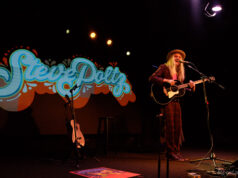
Lee Ann Womack (Photo by Ebru Yildiz)
Lee Ann Womack has two identities as an artist. To casual listeners, Lee Ann is the pop country singer who had a smash mainstream hit with “I Hope You Dance.” More serious fans know Lee Ann for her more traditional country and roots music work — as the face of Spotify’s Americana Icons playlist. Playing to a packed crowd at the Birchmere on Friday, Lee Ann displayed both sides of her identity.
Backed by a six-piece band — electric and acoustic guitar, bass, fiddle, pedal steel, and drums — Lee Ann drew on her extensive repertoire to take her audience on a whirlwind tour of the variety of country music styles. To start the show, she launched into a cover of Buddy Miller’s “Does My Ring Burn Your Finger?” Lee Ann also covered Buddy’s “Don’t Listen to the Wind.” After her first four numbers, Lee Ann stopped to talk the audience and introduce the next song. She spoke about visiting her parents’ house in Texas and going through a box of old photographs. In those photographs, she saw her mother’s face change, and become sadder. She wrote the song “Mama Lost Her Smile” about wrestling with her mother’s happiness, or unhappiness, with life, and when that may have changed.
After a few more songs, Lee Ann returned to talking about her East Texas roots. (She’s from Jacksonville, Texas.) She went back to Texas to make her most recent album — The Lonely, The Lonesome, and The Gone, released last year on ATO Records — and to recapture the musical influences and spirit that shaped her. Lee Ann mentioned George Jones, who she called “a real soul country singer,” Janis Joplin, and Lefty Frizzell as just a few of the East Texas musicians who influenced her.
Lee Ann also emphasized the role of church music in her life. Her father worked at a country music station, and Lee Ann spent countless hours there listening to, as she put it, “real” country singers like Merle Haggard. Her mother worried about all those country songs, with their talk of drinking and womanizing, corrupting young Lee Ann, so she made Lee Ann joined the church youth group. Spending so much time at church, Lee Ann was heavily influenced by gospel music.
In her song “All the Trouble,” Lee Ann said that she tried to combine all these influences. It’s easily the best track on The Lonely, The Lonesome, and The Gone. In a country-meets-blues-meets-gospel number, Lee Ann wailed like a gorgeous blonde banshee.
After more than five minutes of transcendent howling, Lee Ann told the audience she was going to change it up. The band went totally acoustic and formed a tight circle around a single microphone in the center of the stage, like an old-time band. Lee Ann sang a traditional gospel number, “Poor Wayfaring Stranger,” accompanied by simple, lovely harmonies and instrumentation. After the gospel number, Lee Ann covered old tunes by Lefty Frizzell and Don Gibson.
The band went back to their original staging after the Gibson cover. For the last third of the show, Lee Ann sang her own original, pop-country songs. She finished her set with the big crowdpleaser, “I Hope You Dance,” followed by “Ashes by Now.”
Lee Ann’s encore consisted of three numbers, beginning with her “I’ll Think of a Reason Later.” She then asked the audience just how country they could get and went into the Luke McDaniel classic “You’re Still on My Mind.” Lee Ann finished the evening by singing Don Williams’s “Lord, I Hope This Day Is Good.”
The crowded gave Lee Ann a standing ovation, and they cheered, whistled, and hollered throughout the evening. During her encore, Lee Ann signed a t-shirt for a disabled young woman and shook hands with several fans.
Lee Ann Womack is on tour in the South through June. She’s the real deal, and you’re sure to love every minute of her show.






